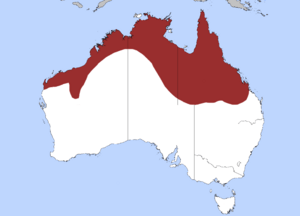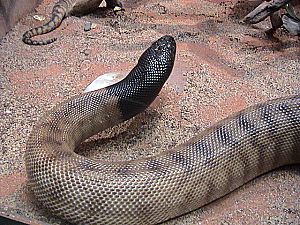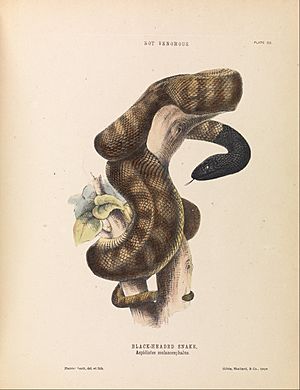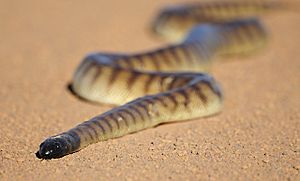Black-headed python facts for kids
Quick facts for kids Black-headed python |
|
|---|---|
 |
|
| Conservation status | |
| Scientific classification | |
| Genus: |
Aspidites
|
| Species: |
melanocephalus
|
 |
|
| Where the black-headed python lives | |
| Synonyms | |
|
|
The black-headed python (Aspidites melanocephalus) is a type of snake that belongs to the python family. These amazing snakes live only in Australia. There are no different kinds or subspecies of this python known today.
Contents
About the Black-Headed Python


Black-headed pythons usually grow to be about 1.5 to 2 meters (5 to 6.5 feet) long. Some can even reach a huge size of 3.5 meters (11.5 feet)! Their bodies are very strong and muscular, and their tails get thinner towards the end.
The top of their head has large, matching scales. Their back scales are smooth and shiny. There are usually 50 to 65 rows of these scales around the middle of their body. On their belly, they have 315 to 355 scales. The scales under their tail are mostly single, with 60 to 75 of them. The scale near their bottom (called the anal scale) is also single.
These snakes have cool patterns with shades of black, dark grey, brown, gold, and cream. These colors can look like stripes or a mix of colors. Their belly is light-colored with darker spots. The top of their head is super shiny black. This black color also goes down their neck and throat for a few inches.
Where They Live and What They Like

You can find black-headed pythons in the northern half of Australia. They do not live in the very dry desert areas. They like places that are humid and tropical, but also some drier areas. The first one ever found and described came from a place called "Port Denison Bowen" in Queensland, Australia.
How They Behave
These snakes live on the ground. You can often find them among rocks and loose stuff. If they feel bothered, they will hiss loudly. But they usually won't bite unless they are hunting for food. Sometimes, they might bump you with their closed mouth. But generally, they are easy to handle. They are also good swimmers, but you almost never see them in water. It's important to know that these snakes are not venomous (they don't have poison).
What They Eat
Black-headed pythons mostly eat other reptiles, including other snakes! But if they can find them, they will also eat mammals. Since they live in warm places, they can heat up quickly. This means they can digest their food faster. Because of this, they can eat more often. When they eat something big, they wrap one or two coils of their body around it. This helps them squeeze the food and swallow it more easily.
How They Have Babies
These snakes lay eggs. This means they are oviparous. A female python usually lays between five and ten eggs at a time. The mother snake will stay coiled around her eggs. She keeps them warm until they hatch, which takes about 2 to 3 months. The baby snakes start eating small prey just two days after they hatch. Young pythons can be eaten by other animals, and sometimes even by bigger pythons! Adult black-headed pythons usually only have two natural enemies: dingos and humans.
As Pets
Many people want black-headed pythons as pets. This is because they are usually calm and have beautiful colors. They are bred in captivity (meaning they are born and raised by people). So, you can get one fairly easily, but they can be quite expensive. If you want one, you need to make sure you have a big enough home for them. You also need to know how to keep them warm and what to feed them.
In Human Stories
The black-headed python is important in the stories of Indigenous Australians. They are often mentioned in their Dreamtime traditions. These are ancient stories that explain how the world was created.


